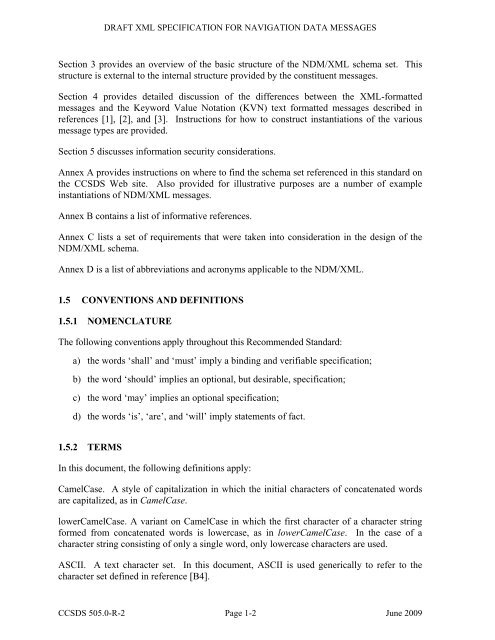XML Specification for Navigation Data Messages - CCSDS
XML Specification for Navigation Data Messages - CCSDS
XML Specification for Navigation Data Messages - CCSDS
Create successful ePaper yourself
Turn your PDF publications into a flip-book with our unique Google optimized e-Paper software.
DRAFT <strong>XML</strong> SPECIFICATION FOR NAVIGATION DATA MESSAGES<br />
Section 3 provides an overview of the basic structure of the NDM/<strong>XML</strong> schema set. This<br />
structure is external to the internal structure provided by the constituent messages.<br />
Section 4 provides detailed discussion of the differences between the <strong>XML</strong>-<strong>for</strong>matted<br />
messages and the Keyword Value Notation (KVN) text <strong>for</strong>matted messages described in<br />
references [1], [2], and [3]. Instructions <strong>for</strong> how to construct instantiations of the various<br />
message types are provided.<br />
Section 5 discusses in<strong>for</strong>mation security considerations.<br />
Annex A provides instructions on where to find the schema set referenced in this standard on<br />
the <strong>CCSDS</strong> Web site. Also provided <strong>for</strong> illustrative purposes are a number of example<br />
instantiations of NDM/<strong>XML</strong> messages.<br />
Annex B contains a list of in<strong>for</strong>mative references.<br />
Annex C lists a set of requirements that were taken into consideration in the design of the<br />
NDM/<strong>XML</strong> schema.<br />
Annex D is a list of abbreviations and acronyms applicable to the NDM/<strong>XML</strong>.<br />
1.5 CONVENTIONS AND DEFINITIONS<br />
1.5.1 NOMENCLATURE<br />
The following conventions apply throughout this Recommended Standard:<br />
a) the words ‘shall’ and ‘must’ imply a binding and verifiable specification;<br />
b) the word ‘should’ implies an optional, but desirable, specification;<br />
c) the word ‘may’ implies an optional specification;<br />
d) the words ‘is’, ‘are’, and ‘will’ imply statements of fact.<br />
1.5.2 TERMS<br />
In this document, the following definitions apply:<br />
CamelCase. A style of capitalization in which the initial characters of concatenated words<br />
are capitalized, as in CamelCase.<br />
lowerCamelCase. A variant on CamelCase in which the first character of a character string<br />
<strong>for</strong>med from concatenated words is lowercase, as in lowerCamelCase. In the case of a<br />
character string consisting of only a single word, only lowercase characters are used.<br />
ASCII. A text character set. In this document, ASCII is used generically to refer to the<br />
character set defined in reference [B4].<br />
<strong>CCSDS</strong> 505.0-R-2 Page 1-2 June 2009

















